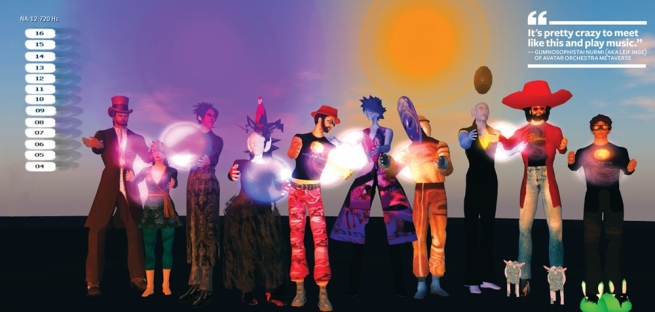
We are sitting in a darkened theatre watching a global collective of musicians making new music. But there’s no one on stage. Instead, we are looking at and listening to an audiovisual projection of the performers playing telematically through an online three-dimensional virtual-reality platform. I am gobsmacked that these performers from around the world are improvising in real time through their online avatars. This is a far cry from my attempts twenty-five years ago to turn my Commodore 64 into a MIDI synth. But as the sound from the loudspeakers hits my ears, the experimental music practitioner in me is immediately cynical, unsatisfied by technology for technology’s sake. Well . . .
The gap between the feats of sound that technology can achieve and the quality of art in the application of said technology is a gap that needs to be crossed carefully. The most successful works of experimental art are those that, in applying a new technology, take the form and content of the art to places we have never before seen or heard. Technology, meet craft.
Is the gap between new technology and well-applied skills representative of the classic fight between the elite and the uninitiated? Many musicians have suffered through the audition of a neighbour’s nephew’s MIDI symphony, or a party acquaintance’s derivative GarageBand loops. This is a paradigm with a long tradition. As each new technology becomes affordable and widely available, there will always be those who had the privilege of first access decrying the usurpation of the technology by undeserving practitioners.
Alternatively, is the reluctance to fully explore the transformation of sound by technology a manifestation of our cyberpunk-dystopian fears? Anything using technology—including the creation of art—will, in short order, become dominated by the technology. But where do you draw the line on what constitutes technology? Imagine how the classic Greeks may have responded to music produced with a piano or the Victorians’ reaction to computer music. Can you imagine a world without recorded sound? Technology, meet fearlessness.
Bad art has never toppled a society. Bad art is just, well . . . bad. And it is a small price to pay in making the technological tools accessible to a lot of people. It’s the vision in applying the tools that counts.
The musicians featured in this issue have all risen in their own unique ways to the challenge that technology poses to artistic practice. Amsterdam’s STEIM, a live-electronic-music centre exclusively dedicated to the performing arts, was one of the first institutions to question how music technology was used, when, in 1967, its members began building instruments to expand electronic music’s expressivity and live music-making’s possibilities. Their electronic instruments and live sound-processing software were some of the first tools used to bring electronic musicians out of the studio and onto the stage. In the STEIM tradition, Montreal flutist Cléo Palacio-Quintin was frustrated with her inability to control sound-processing software while performing with her flute. In response, she built the hyper-flute, a flute affixed with sensors used to capture specific performance parameters that in turn are mapped to a MIDI interface and used to drive Max/MSP software. New York City composer Tristan Perich takes sound technology one step further, combining form and content in his 1-Bit Symphony. Housed in a circuit and set into a CD jewel case, it utilizes on-and-off electrical pulses, synthesized by assembly code and routed from microchip to speaker, to manifest data as sound. But not all artists use technology in pursuit of new tools and forms. Others, like sound artist Paul Walde, use it to magnify what is already there. His work is in the vanguard of a new movement in contemporary art, exploring what happens when cultural artifacts intersect with the natural world—and he uses technology as a link between these two spheres. Technology, meet imagination.
The artists covered in this issue approach technology in their art practices with a sense of wonder while employing a judgmental faculty. Be in awe of the new, but don’t suspend the hard-won critical faculty that years of listening and practising have brought. Technology in service of art trumps art in service of technology every time. To the fearless originals go the spoils.
Image: The Second Life avatars of international improv collective Avatar Orchestra Metaverse. Image by: Tina Pearson.